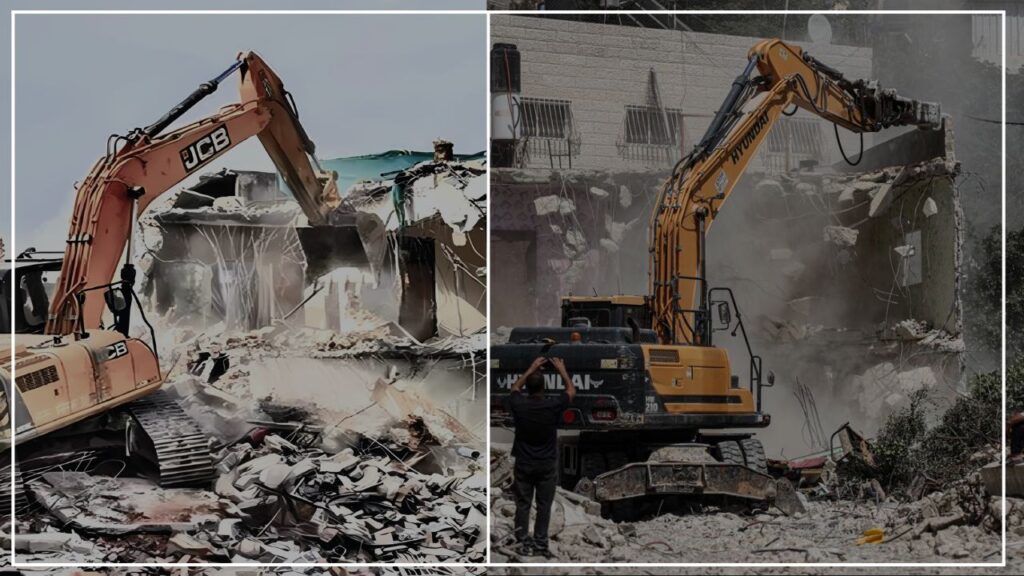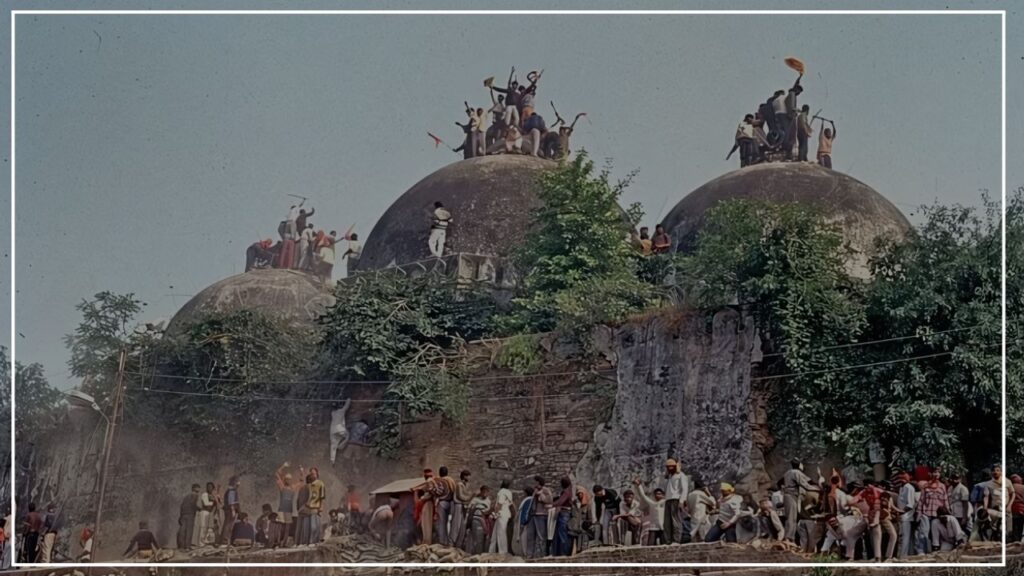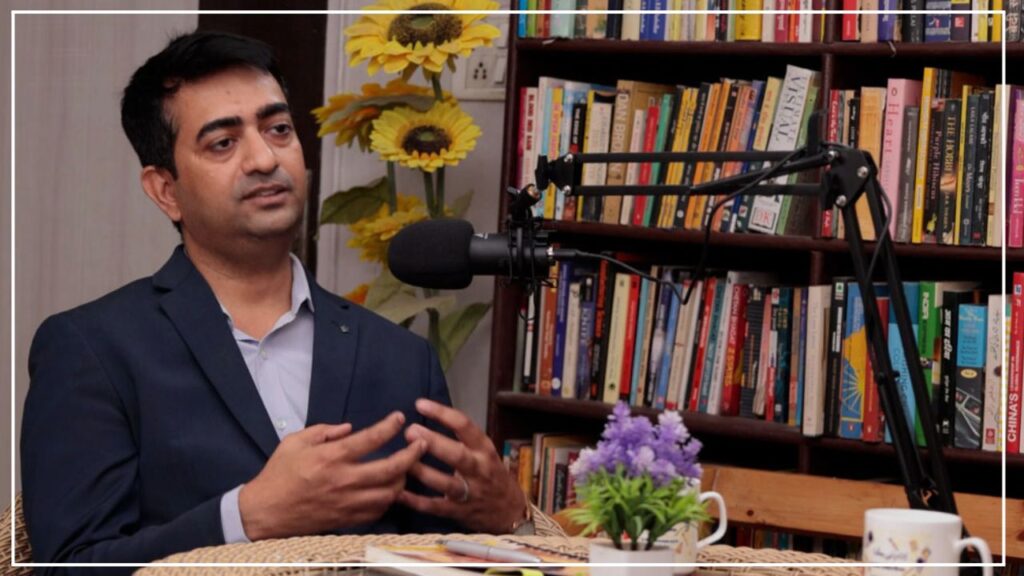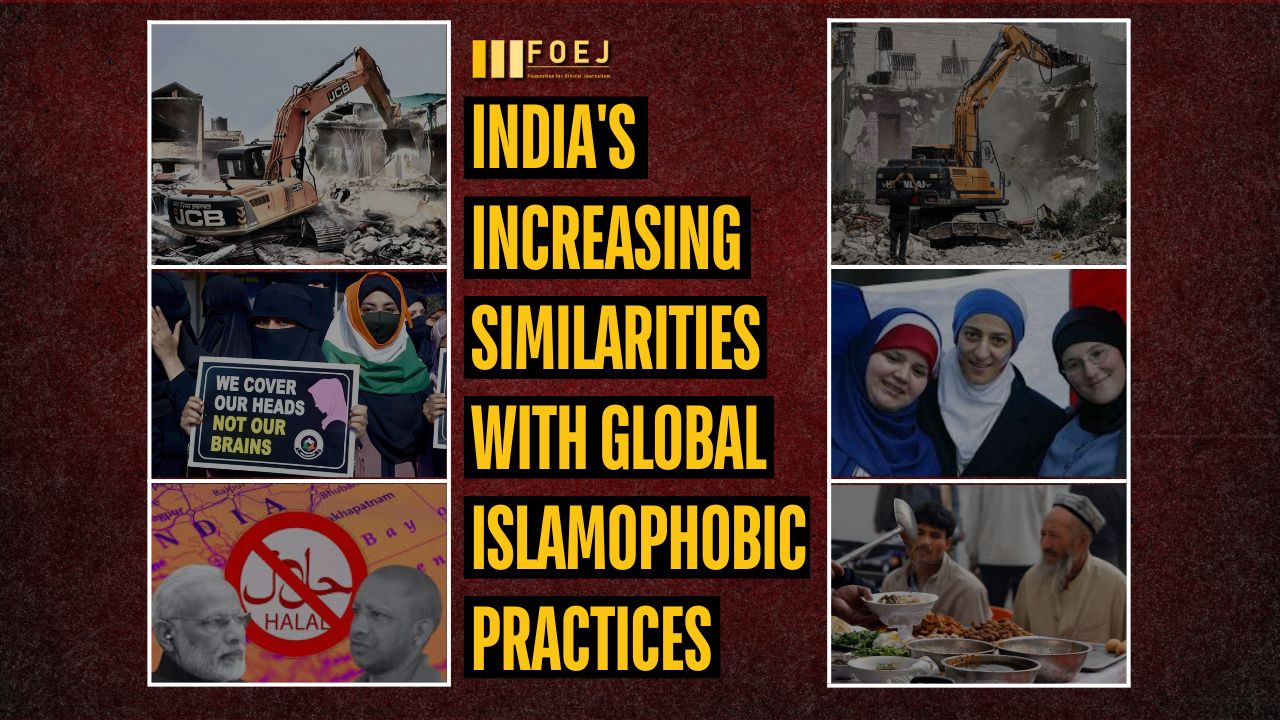Islamophobia is not a new trend in India, every day the Muslim minority witnesses a surge in hatred due to numerous factors; the ‘saffronisation’, ‘demolition’, hate speeches’, and mosque targeting are a few of them. Inspired by the notion that seems to support the hegemony of Hindu nationalism and reshaping the country’s socio-political landscape, the democratic country India witnesses a staggering resemblance with other countries’ strategies to target a particular community. Moved by Israel’s house demolition strategy, France’s hijab ban politics,Chinese targeting of mosques and halal foods, India has drawn a parallel line with global islamophobic practices. With riots and violence in every nook and corner, the country has given a series of onslaughts on its innocent citizens. The aim of this article is to highlight the uncanny similarities between India and other countries’s tactics to target a large portion of the minority.
Lawful Demolition or Forced Democide?
In order to understand the frequent demolitions by the Indian government, one needs to know about Israel’s “Defence Regulations Act.” Since 1967, Israel has demolished the homes of Palestinians suspected or convicted of attacking Israelis. This measure is enforced under Regulation 119 of the Defence (Emergency) Regulations, which originate from the British Mandate era. The regulation permits the military to demolish a home based solely on suspicions of an offense. and Israel justifies these demolitions as a deterrent. But what is happening today in India seems like a similar move as in Israel.

As per the reports of the Housing and Land Rights Network (HLRN)’ 2024, state and central governments demolished 1,53,820 homes in 2023 and 2022, evicting about 7,38,438 people from rural and urban regions. The report further revealed that, from 2017 to 2023, eviction affected more than 1.68 million individuals.
Community Violence Demolition
Preliminary research by HLRN indicates that from January 1 to July 15, 2022, state authorities across India demolished over 25,800 homes, impacting at least 124,450 people. These evictions took place despite the third wave of the COVID-19 pandemic, which affected livelihoods and lives between January and March 2022.
The Housing and Land Rights also revealed data that, following the communal violence during Ram Navami and Hanuman Jayanti celebrations in April 2022, authorities in Madhya Pradesh demolished 16 houses and 29 shops belonging to Muslim families in Khargone district, including a home built under the Pradhan Mantri Awas Yojana (Housing for All) Scheme. Government officials and ministers indicated that these demolitions were intended as punishment for those the state believed were involved in the clashes. Similar actions were taken in Khambhat and Himmatnagar in Gujarat, where Muslim families were also affected.
Demolitions ahead of Protests
It further highlighted that in June 2022, municipal authorities in Uttar Pradesh’s Prayagraj and Saharanpur districts demolished the homes of Muslim families under the pretext of removing “encroachments.” These actions were after the protests by the Muslim community against controversial religious remarks.
Similarly, in Jirapur Village, Madhya Pradesh, after a clash between the local Muslim and Dalit communities, state authorities demolished 18 homes belonging to Muslim families accused in the incident. Additionally, around 30 houses in the predominantly Muslim neighbourhood were partially demolished, allegedly to remove encroachments, though the action was widely seen as collective punishment against the community.
The research conducted by Housing and Land Rights Network also shed light on the fact that government agencies have conducted evictions and demolitions under the guise of removing “encroachments” and “illegal structures” from public land. However, this justification has been used to selectively target certain settlements.
“Send Rioters a Message”
Since 2019, the “Bulldozer Justice” has targeted a large portion of Indian Muslims, leaving them homeless within hours. In the month of April in 2022, the bulldozer justice was celebrated in Khargone by many politicians, media, netizens, and citizens. Around 50 properties were razed to the ground, and reportedly almost all of them were from the Muslim community. The affected areas included the Chhote Mohan Talkies locality, followed by Aurangpura, Khaskhas Wadi, Ganesh Mandir, and Talab Chowk. These properties were torn down to “Send Rioters a Message” after the communal violence that took place following the communal violence on Ram Navami.
Nuh Demolition Drive
The Nuh Demolition Drive is one of the major drives that took place in India and affected around 443 structures, of which 162 were permanent and 281 were temporary. The number of persons reportedly affected by the demolition drive was 354, of which 283 were Muslims. This chilling demolition drive was carried out after violence erupted in July in Nuh after
Subjugating Muslims Through Economic Exclusion
Both China and India have stamped a brutal mark on their lands by targeting the food industries. In recent years, China has introduced and implemented a series of policies that restrict the production and labelling of halal food, particularly targeting the practices associated with Muslim minorities. This policy is part of a broader picture to curb what the government describes as “pan-halal tendencies,” which refers to the extension of halal concepts beyond food to various consumer products, including water and personal care items.
The uncanny similarity between China’s “pan-halal tendencies” and India’s Shoorvir program’ or labelling “halal” as an offence against the Food Safety and Standards Act, 2006, reflects the latter’s tactics to polarise the country.
Shoorvir Programme
“From Hindu Nation to Hindu World”
The Shoorvir Programme was launched approximately two years ago, according to statements from its representatives. Developed under the guidance of the New Education Welfare Society, the initiative was established to create an economic ecosystem specifically for the Hindu community, focussing on providing employment and community services exclusively for Hindus.
As reported by The Newslaundry, in June 2024, the Hindu Janjagriti Samiti hosted the Vaishvik Hindu Rashtra Mahotsav in Goa, centered around the theme “From Hindu Nation to Hindu World.” Among the speakers was Virendra Pandey, founder of the Shoorvir Programme, a service aimed at linking Hindu service providers with Hindu clients.
At the Vaishvik Hindu Rashtra Mahotsav, Pandey delivered a speech in which he warned against letting “those people” into one’s home. “Most men in cities go to work, leaving mothers and sisters at home. In such situations, if they call someone to fix a broken AC, imagine a Vidharmi [non-believer] entering the most private parts of your house. He gains detailed knowledge of your home—how many sisters, daughters; old or young; who comes and goes, and when. This is how 80-90 percent of jihad begins to take root when we allow a non-believer into our homes.”
The Shoorvir Programme’s mission statement says, “We must unite constructively in a cohesive manner so that every penny you spend reaches our people only.”
Halal an offense against the Act!
In yet another incident, Anita Singh, Commissioner, Food and Safety and Additional Chief Secretary, Uttar Pradesh Food and Safety, and Additional Chief Secretary, issued a statement on November 18, 2021, stating that labeling dairy products, bakery, oil, snacks, edible oil, medicines, medical devices, and cosmetics as “halal” was an offense against the Food Safety and Standards Act, 2006.
The notification announces a ban on the production, storage, distribution, and sale of halal-certified products: “The halal certification of food products is a parallel system that creates confusion and is against the law. Halal labeling on medicines and cosmetic products amounts to misleading the consumer about the safety of food products,” the statement stated.
Kanwar Yatra
Earlier this year, an apparent targeting of Muslim shops took place during Kanwar Yatra. Authorities in Uttar Pradesh and Haridwar mandated that all eateries along the Kanwar Yatra route display the names of their owners. This move, however, received several criticisms and was viewed as specifically targeting Muslim-owned businesses. Asaduddin Owaisi, the AIMIM chief, described the order as reflecting “visceral hatred” towards Muslims, while Congress leaders have labeled it as “state-sponsored bigotry” aimed at normalizing economic discrimination against Muslims.

Alignment with the France Hijab Ban
To wear hijab (a mandatory practice for Muslim girls) or not to wear it has been a heated debate in India for a long time now. This debate seems to have drawn its inspiration from France’s 2004 law. France, the home to Europe’s largest population, on February 10, 2004, approved an international controversial ban on the hijab. This move was developed despite the fact that Islam is the second largest religion in France.
However, the debate on hijab was not new in France; it rooted in the year 1989, when France Minister of Culture, Francois Byrou, issued a statement asking for the hijab ban to be forbidden as an “ostentatious religious symbol.”
Following this, in 1999, 17 schoolgirls were expelled from France state schools for wearing the hijab. On December 11, 2003, a French government-sponsored commission issued a report recommending a federal law banning “conspicuous religious symbols” in public schools. However, in 2004, the French commission recommended against imposing a similar sanction in universities, citing that students at that level have reached the age of majority.
Karnataka Hijab Ban
Allegedly following in the footsteps of France, the democratic country India, too, banned hijab. In the early months of 2022, a conflict over school uniforms erupted in Karnataka, India, after a group of Muslim students at a junior college were barred from attending classes for wearing the hijab. The college administration claimed that the hijab violated the institution’s uniform policy, which was uniformly applied to all students, regardless of their religion.

As the issue gained attention, it quickly spread to other educational institutions across the state. In response, groups of Hindu students began counter-protests, demanding the right to wear saffron scarves to classes. On February 5, 2022, the Karnataka government intervened by issuing an order mandating that uniforms be worn where policies existed, without exceptions for religious attire. This directive led several schools and colleges to deny entry to Muslim girls who wore the hijab.
The affected students took the matter to the Karnataka High Court, seeking legal relief. On February 10, 2022, the High Court issued an interim order prohibiting all students from wearing any form of religious clothing while the case was pending. The order was enforced across Karnataka, leading to instances where students, and even teachers, were required to remove hijabs and burkas before entering school premises.
After this, a survey by the People’s Union for Civil Liberties (PUCL) found that over 1,000 hijab-wearing girls dropped out of pre-university colleges in Karnataka due to the ban. The report highlighted that many students faced harassment and humiliation for wearing the hijab, which contributed to their decision to leave school.
Targeting of Holy Sites
In order to alter the identity of Uygur Muslims and to force them into Chinese identity, the Uyghurs’ faith has been an easy and major target of the Chinese government. The Chinese government has in essence targeted the tangible signs of the Uygurs’s faith, their mosque. The Chinese Government started the mosque demolition in 2016 and named it the “Mosque Rectification Program,” and the Chinese vandalized and destroyed an unprecedented number of mosques.
According to a Radio Free Asia (RFA) report, as many as 5,000 mosques were destroyed over the course of three months. A survey of 100 religious sites conducted by the Guardian and Bellingcat revealed that 31 mosques and two shrines were vandalized between 2016 and 2018, with 15 completely demolished as well as a further nine mosques, which could not be confirmed by their team as demolished. Meanwhile, Agence France-Presse (AFP) worked with Earthrise Alliance and confirmed 30 mosques and religious sites had been demolished and six more had their Islamic architectural features removed.
Furthermore, the Chinese government escalated its efforts to tighten control over the Uyghur region, a strategic move aimed at securing access to the area’s rich resources and establishing it as a key platform for the Belt and Road Initiative into Central Asia. As part of this strategy, a campaign of forced assimilation was launched, targeting Uyghurs and other Turkic groups. This campaign seeks to erase their distinct language, religion, and culture, raising serious concerns about the preservation of these communities’ identities.
However, the same pattern seems to be followed by the Indian government. Every other day, the country reads about the vandalisation and demolition of holy sites of Muslims. The 6th of December is considered a black day by Muslims all over India. On this day in 1992, the Hindu nationalist militants climbed up the centuries-old mosque (Babri Masjid) and, with a hammer, piper, and sticks, vandalized the holy structure to the ground.

This was reportedly done in the presence of a large number of police. The Hindu nationalists reportedly justified their move by claiming that the Muslim emperor had built the mosque on the ruins of a Hindu temple, the birthplace of their god Ram.
November 9, 2019
On November 9, 2019, the final judgment of this vandalisation was declared by the Supreme Court of India. The court ordered the disputed land (2.77 acres) to be handed over to a trust that was created by the Government of India to build the Ram Janmabhoomi temple.
Other major demolitions
Masjid Akhunji, New Delhi
Imam Zakir Husian and small kids woke up to the loud sound of a bulldozer on January 30, 2024, and within an hour their mosque was demolished along with the madrassa adjacent to it. The centuries-old Mosque Akhunji was razed down to the ground without prior notice, and their residents were made homeless within an hour.
The mosque and the madrassa that was home to about 25 kids were razed down by the Delhi Development Authority (DDA).
Shahi Masjid, Prayagraj
When the world was celebrating the beginning of the new year in January 2023, the Muslim residents of Prayagraj were mourning the loss of their Shahi Masjid. The Shahi Masjid was a historic 16th-century mosque and was razed down on the pretext of a road widening project.
Gujarat Demolition
Peoples Union for Human Rights (PUHR), a human rights organization, closely scrutinised the anti-Muslim riots in Gujrat and had also published its report in context of the mosque demolitions. According to the reports, in the whole of Gujrat, the demolition of nearly 500 mosques and shrines took place with impunity. In addition to this, according to the numbers obtained from Surinder Khochar, an Indian researcher, 650 mosques of various sizes have disappeared in Amritsar in an anti-Muslim drive till 2023.
These are just a few glimpses of the dehumanization faced by the Muslim community in democratic India. To gain deeper insights, FoEJ Media conducted an exclusive on-ground interview with Aasif Mujtaba, the Founder and Director of Miles2Smile. Mujtaba’s organization is dedicated to providing relief and rehabilitation to survivors of mob lynching, demolitions, and communal violence.
On being asked about the impact of these heinous acts on survivors, Mujtaba said, “I everyday come across people who have witnessed these acts, the story they share can mow down anyone’s heart.”
“We read about the news of these acts and their survivors but they are more than just news and their suffering are more than just news headlines.” Mujtaba added.

“From big cities like Delhi to small villages like Mewat, the demolition drive has targeted muslims in every nook and corner of the country and this raises a big question on the justice system of the country,” He said.
The pattern of targeting Muslim communities through demolitions, economic exclusion, and religious restrictions in India mirrors the global Islamophobic practices seen in countries like Israel, China, and France. The consistent use of state machinery to dismantle the homes, livelihoods, and religious freedoms of Muslims in India is not only a reflection of domestic political dynamics but also a sign of a disturbing global trend. As these practices continue, the implications for India’s democratic values and social value grow increasingly dire, raising critical questions about the future of minority rights and religious freedom in the country.









